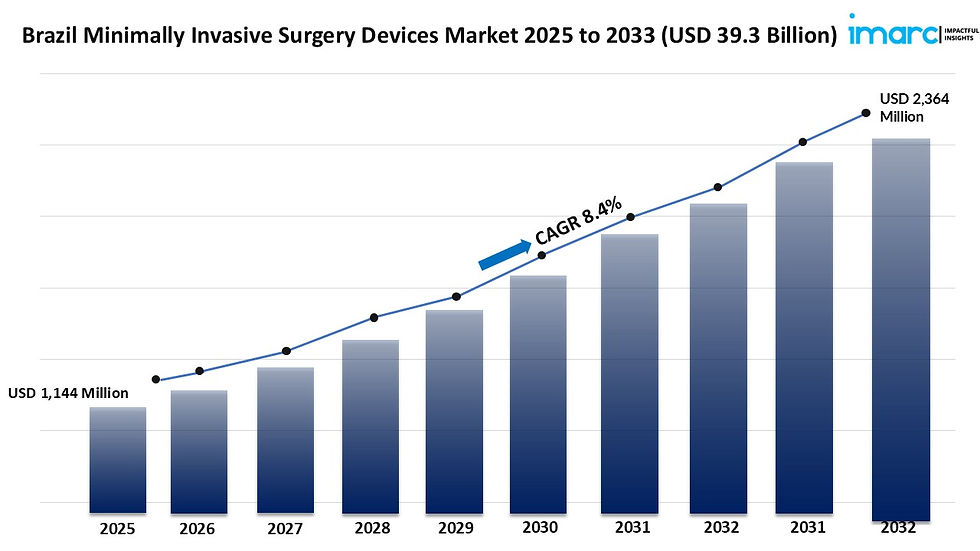Brazil Minimally Invasive Surgery Devices Market Size, Share, Growth, Trends 2025-2033
- Lakshy Gagda
- Aug 11, 2025
- 4 min read
Brazil Minimally Invasive Surgery Devices Market Overview
Market Size in 2024: USD 1,144 Million
Market Forecast in 2033: USD 2,364 Million
Market Growth Rate: 8.4% (2025-2033)
According to the latest report by IMARC Group, the Brazil minimally invasive surgery devices market size was valued at USD 1,144 Million in 2024. Looking forward, IMARC Group estimates the market to reach USD 2,364 Million by 2033, exhibiting a CAGR of 8.4% from 2025-2033.

Brazil Minimally Invasive Surgery Devices Industry Trends and Drivers:
Rising Adoption of Advanced Surgical Technologies
The Brazil minimally invasive surgery devices market is witnessing significant growth as healthcare providers are increasingly adopting advanced technologies that enable precise, less traumatic, and faster surgical interventions. Surgeons are utilizing specialized devices, such as handheld instruments, guiding systems, and electrosurgical tools, to perform procedures that minimize tissue damage and promote quicker recovery.
Patients are demonstrating a growing preference for minimally invasive options due to reduced postoperative discomfort, shorter hospital stays, and lower complication risks. Hospitals and specialty clinics are integrating modern operating room equipment, including monitoring and visualization systems, to enhance surgical accuracy and patient outcomes. The demand for endoscopic and laparoscopic devices is expanding as these solutions offer improved visibility and access during complex procedures, particularly in fields like gastrointestinal, gynecological, and urological surgery.
Government initiatives aimed at improving healthcare infrastructure are facilitating the procurement of cutting-edge devices, while training programs are equipping medical professionals with the skills to adopt these advanced techniques. The market is also benefiting from rising medical tourism, as Brazil’s healthcare facilities are positioning themselves as competitive destinations for cost-effective, high-quality surgical care.
Continuous product innovations and the integration of robotics and AI-assisted technologies are further elevating precision standards and expanding the scope of minimally invasive treatments across the country.
Diversification Across Multiple Clinical Applications
The Brazil minimally invasive surgery devices industry is diversifying rapidly, with applications spanning cardiovascular, orthopedic, aesthetic, and neurological procedures. Hospitals are investing in versatile device platforms that allow multiple procedure types to be performed using a unified system, optimizing resource utilization and cost efficiency.
Cardiovascular interventions are increasingly using advanced catheter-based devices to reduce the need for open-heart surgery, while orthopedic treatments are leveraging arthroscopic systems for joint repair and reconstruction with minimal disruption to surrounding tissues. Aesthetic surgery demand is growing alongside patient interest in body contouring and facial rejuvenation procedures that involve minimal downtime. Neurological applications are also expanding, supported by innovations in laser-based and ablation devices that enable targeted treatments for complex disorders.
The proliferation of high-definition imaging and 3D visualization tools is enhancing surgical precision, allowing practitioners to navigate intricate anatomical structures with greater confidence. Rising public awareness campaigns and patient education initiatives are informing individuals about the benefits of minimally invasive solutions, driving preference away from traditional open surgeries. Collaborative partnerships between medical device manufacturers and healthcare institutions are ensuring continuous feedback and iterative product improvements, positioning the industry for sustained expansion.
Strategic Investments and Market Expansion Opportunities
The Brazil minimally invasive surgical devices sector is advancing through strategic investments in research, development, and clinical training. Domestic and international manufacturers are expanding their presence through localized production facilities, reducing lead times and making advanced devices more accessible to healthcare providers. Strategic acquisitions and partnerships are enabling technology transfers, fostering innovation, and strengthening distribution networks across both urban and regional healthcare markets.
Private hospitals are adopting bundled service models, integrating advanced devices into comprehensive treatment packages to attract both local patients and international medical tourists. The increasing availability of financing options and leasing arrangements for high-value surgical equipment is allowing smaller clinics to adopt state-of-the-art solutions, broadening market penetration. Regulatory bodies are streamlining approval processes for new devices while maintaining strict quality standards, facilitating the introduction of next-generation surgical tools.
The emphasis on minimally invasive approaches aligns with Brazil’s broader healthcare modernization agenda, creating a favorable policy environment for industry growth. With rising demand for efficient, patient-centric surgical care and continuous advancements in device capabilities, the market is positioning itself as a dynamic hub for innovation in Latin America. This momentum is establishing Brazil not only as a leading domestic market but also as a significant exporter of high-quality surgical technology solutions.
Download a sample copy of the Report: https://www.imarcgroup.com/Brazil-Minimally-Invasive-Surgery-Devices-Market/requestsample
Brazil Minimally Invasive Surgery Devices Industry Segmentation:
The report has segmented the market into the following categories:
Product Insights:
Handheld Instruments
Guiding Devices
Electrosurgical Devices
Endoscopic and Laparoscopic Devices
Monitoring and Visualization Devices
Ablation and Laser-Based Devices
Others
Application Insights:
Aesthetic
Cardiovascular
Gastrointestinal
Gynecological
Orthopedic
Urological
Others
Regional Insights:
Southeast
South
Northeast
North
Central-West
Competitive Landscape:
The competitive landscape of the industry has also been examined along with the profiles of the key players.
Key highlights of the Report:
Market Performance (2019-2024)
Market Outlook (2025-2033)
COVID-19 Impact on the Market
Porter’s Five Forces Analysis
Strategic Recommendations
Historical, Current, and Future Market Trends
Market Drivers and Success Factors
SWOT Analysis
Structure of the Market
Value Chain Analysis
Comprehensive Mapping of the Competitive Landscape
Note: If you need specific information that is not currently within the scope of the report, we can provide it to you as a part of the customization.
Ask the analyst for your customized sample: https://www.imarcgroup.com/request?type=report&id=14262&flag=C
About Us:
IMARC Group is a global management consulting firm that helps the world’s most ambitious changemakers to create a lasting impact. The company provide a comprehensive suite of market entry and expansion services. IMARC offerings include thorough market assessment, feasibility studies, company incorporation assistance, factory setup support, regulatory approvals and licensing navigation, branding, marketing and sales strategies, competitive landscape and benchmarking analyses, pricing and cost research, and procurement research.
Contact Us:
IMARC Group
134 N 4th St., Brooklyn, NY 11249, USA
Email: sales@imarcgroup.com
Tel No:(D) +91 120 433 0800
United States: +1-631-791-1145



Comments